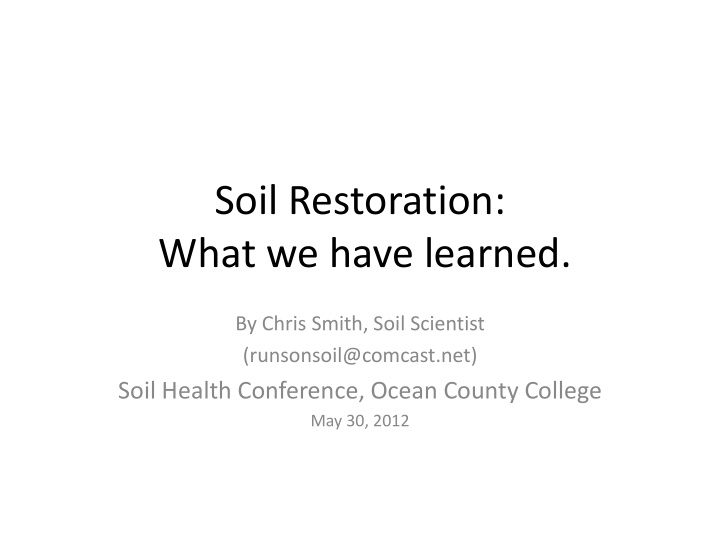



Soil Restoration: What we have learned. By Chris Smith, Soil Scientist (runsonsoil@comcast.net) Soil Health Conference, Ocean County College May 30, 2012
Fix Root causes of problems as well as bandaging the wounds. • Remove the nail in the sole of your boot and buy a new pair of socks. • Problems associated with runoff are often symptoms of reduced infiltration resulting from poor soil health, thus the solution is to fix the health of the soil
Soil Functions A Guide to Restoration • Medium for Plant Growth • Regulator of Water Supplies • Modifier of the Atmosphere • Recycler of Raw Materials • Habitat for Soil Organisms • Engineering Medium – 14 th Ed. The Nature and Properties of Soils
Secret to Reducing Runoff Put it in the ground as close to where it falls as possible • Reduce the collection of water to one place • Spread the infiltration of water over the largest area. Utilize safe outlets in the woods – Build • Depressional woodlands as – Multi- chambered basin like a cranberry bog (200’) – Multi-basined waterway with drop structure – Remove • Low flow channels
Basic Conditions Increase Upland Infiltration to Improve Basin functioning Disturbed Degraded Natural Functions Functions Maintained Upland Abrupt layers Reduced Uncompacted/ Good Filter Little water Compacted/ growth Alive Meters water Lifeless Elevated runoff Basin Abrupt Layers Reduced Uncompacted? Poor filter Big water can Compacted growth /Alive High infiltration become water Poor filter compacted Lo Infiltration
Mimic the Natural Soil • Disturbed • Natural – C or A-C horizon – O-A-B-C horizons – Hi/variable SOM on a % wt. – SOM concentrated at basis surface and distributed to lower depths • Hi SOM on a % wt. basis • Lo SOM on areal – Exposed mineral – Organic blanket – High Density in surface – High density with depth – All pores uniform sized – Mixture pore sizes – Pores unconnected – Pores connected in a net – No organisms – Ants or earthworms – Often saturated – Seldom saturated
Construction/Rehab Soil • These processes are all inter-connected – Additions • Adding compost, increasing aeration – Depletions • Leaching, gaseous losses, organic matter removed – Transformations • Avoiding reducing iron and manganese – Translocation
Don’t attempt to Fix what is not broken! • Soil Assessment First – Saves time and Money and avoids doing more harm than good!! – Is it so bad that it will not self correct without mechanical treatment? – What minimium surface depth would need to be restored to be equal or better than subsurface? – What precautions should be in place?
Soil Assessment • Rod test, if it passes to >20” and the surface of 6” has a distinctly dark surface and visible organisms. • Bulk Density • Ksat • Texture • pH and % SOM to calculate total areal SOC
Biological Activities Capture the Sun’s Energy Add Soil Organic Matter Subtract Soil Organic Matter • Plant growth, green manure • Worms and deer • Compost • N Fertilizer • Slow steady aeration • Tillage and Incorporation • Keep it on the surface • Incorporation • Forest and Fungus • Grass and bacteria – Hi C:N ratio – Low C:N ratio • Low Albedo - Hi Entropy • Hi Albedo – Lo Entropy – Cool and moist – Hot and dry • Innoculate • Wait for life to return
All three factors interrelated Biological Chemical Physical
Chemical Environment controls direction/efficiency of biological Desirable for forest landuse Undesirable for forest landuse • Lo pH favors Oak/Pine • Hi pH favors Maple • Lo pH favors Oak/Hickory • Hi pH favors grass • Lo pH favors forest • Hi pH stable aggregates electrically • Lo pH stable aggregates biologically in long run
Physical Factor Activities Leave no trace, walk on it as if you needed snowshoes Favors Health Degrades health • Add fractures to create • Too much or little aeration macropores , however, must • Heavy traffic, consider both stabilize chemically and the Ground pressure biologically to maintain (psi)and the total loading( double the weight with the same psi means twice as wide and twice as deep) • Wait until the soil is dry enough to gain strength (<5% water)
Dos and Don’ts Do Don’t • Dig and Drop only when the • Dig up extra courser soil natural structure would be from below to create a single grained, and have blend of more sandy mix. It only particle to particle will not be enough sand to pores at most. achieve single grain, and it will not develop aggregate porosity before forming a massive self compacted impermeable layer.
Surface Horizons Figure 3-13 NSSM • Mechanically bulked • Tillage - loose & friable • Mechanically compact • Traffic pan - dense • Water compacted, • Action of large changes in repetitive occurrence of water state without free water mechanical load except for the weight of the soil. Weak to massive • Compaction by rain • Crust <2” • Transported materials • Fluventic Zone <2”
Recommend
More recommend